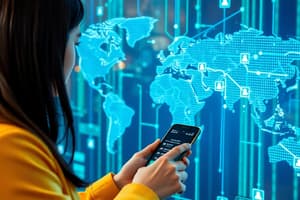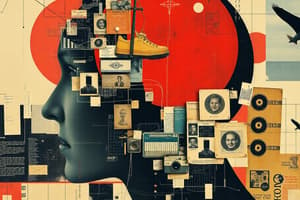Podcast
Questions and Answers
What are the main goals of artificial intelligence systems?
What are the main goals of artificial intelligence systems?
- To map and track global pandemics
- To create new social media platforms
- To solve problems with mathematical equations in PowerPoints
- To understand and respond to human language (correct)
Which of the following is NOT a technological tool mentioned in the text that helps address social issues?
Which of the following is NOT a technological tool mentioned in the text that helps address social issues?
- MathType Plugin (correct)
- Computationally intense modeling software
- Crisis-mapping tools
- Social media platforms
What term describes the difference in access to technology across various regions of the world?
What term describes the difference in access to technology across various regions of the world?
- Internet disparity
- Digital divide (correct)
- Accessibility inequality
- Technological gap
What is an example of technology impacting the way we consume products and services?
What is an example of technology impacting the way we consume products and services?
Which learning objective focuses on the impact of technology on human connection and collaboration?
Which learning objective focuses on the impact of technology on human connection and collaboration?
What is cognitive surplus?
What is cognitive surplus?
What is Web 2.0?
What is Web 2.0?
How is crowdfunding related to supporting other people's dreams?
How is crowdfunding related to supporting other people's dreams?
What is collaborative consumption?
What is collaborative consumption?
What is computer literacy?
What is computer literacy?
What is a key characteristic of artificial intelligence (AI)?
What is a key characteristic of artificial intelligence (AI)?
What is an example of a technology that has contributed to the development of functional AI systems?
What is an example of a technology that has contributed to the development of functional AI systems?
What is a defining feature of artificial neural networks?
What is a defining feature of artificial neural networks?
What is a key characteristic of machine learning (ML)?
What is a key characteristic of machine learning (ML)?
What is a defining characteristic of deep learning (DL)?
What is a defining characteristic of deep learning (DL)?
What does the term 'data mining' refer to?
What does the term 'data mining' refer to?
How can businesses leverage data mining?
How can businesses leverage data mining?
Which of these is NOT considered a characteristic of a savvy computer user?
Which of these is NOT considered a characteristic of a savvy computer user?
What is a key benefit of keeping computer software up to date?
What is a key benefit of keeping computer software up to date?
Which of these is NOT an example of being a savvy computer user?
Which of these is NOT an example of being a savvy computer user?
Flashcards
Learning Objectives
Learning Objectives
Goals defining what learners should achieve through instruction.
Digital Divide
Digital Divide
The gap between those with access to technology and those without.
Artificial Intelligence (AI)
Artificial Intelligence (AI)
Systems designed to perform tasks that typically require human intelligence.
Crisis-Mapping Tools
Crisis-Mapping Tools
Signup and view all the flashcards
Ethics
Ethics
Signup and view all the flashcards
Web 2.0
Web 2.0
Signup and view all the flashcards
Cognitive Surplus
Cognitive Surplus
Signup and view all the flashcards
Crowdfunding
Crowdfunding
Signup and view all the flashcards
Collaborative Consumption
Collaborative Consumption
Signup and view all the flashcards
Savvy Computer User
Savvy Computer User
Signup and view all the flashcards
Avoiding Hackers
Avoiding Hackers
Signup and view all the flashcards
Protecting Privacy
Protecting Privacy
Signup and view all the flashcards
Understanding Real Risks
Understanding Real Risks
Signup and view all the flashcards
Using the Web Wisely
Using the Web Wisely
Signup and view all the flashcards
Computer Maintenance
Computer Maintenance
Signup and view all the flashcards
Machine Learning (ML)
Machine Learning (ML)
Signup and view all the flashcards
Deep Learning (DL)
Deep Learning (DL)
Signup and view all the flashcards
Data Mining
Data Mining
Signup and view all the flashcards
Study Notes
Chapter 1: The Impact of Technology in a Changing World
- Technology Requirements: For mathematical equations in the PowerPoint presentation, ensure these programs are installed: MathType Plugin, Math Player (free versions available), and NVDA Reader (free versions available).
- Learning Objectives (1 of 2):
- Describe various technological tools impacting national and global issues.
- Describe various global social issues affected by technology.
- Describe how technology changes connection and collaboration.
- Summarize technology's impact on product and service choices.
- Define computer literacy and its importance.
- Learning Objectives (2 of 2):
- Describe artificial intelligence systems and their goals.
- Describe AI and other technologies' importance in careers.
- Define and describe various ethical systems.
- Describe personal ethical development influences.
- Present examples of technology's ethical challenges.
- Technology in a Global Society (Objective 1.1):
- Social networking tools allow groups to connect and share ideas.
- Crisis-mapping tools gather and map information.
- Examples include Twitter, Facebook, and Instagram, enabling people to connect and address shared problems like social change.
- Crisis mapping tools rapidly make information public.
- Technology in a Global Society (Objective 1.2):
- Health Care:
- Scientific visualization tools help scientists develop antibodies and improve vaccine discovery.
- Data could alert scientists to new trends.
- COVID-19 pandemic highlighted global health challenges.
- Scientific Tools:
- Tools help scientists solve issues affecting public health.
- Computationally intense modeling software is used to develop and deploy solutions like antibody tests.
- The Digital Divide:
- A substantial difference exists in Internet access and technical tool availability globally.
- This disparity prevents comprehensive problem-solving.
- Health Care:
- Technology Connects Us with Others (Objective 1.3):
- Web 2.0 allows easier content contribution, connections, and collaboration.
- Cognitive Surplus describes the combination of leisure time and tools to be creative.
- Sharing Economy:
- Access vs. Ownership:
- Concepts of ownership change in technology.
- Items become subscriptions instead of purchases.
- Examples include car-sharing (ZipCar) and bike-sharing (Citi Bike).
- Collaborative consumption: sharing resources and products efficiently.
- Access vs. Ownership:
- Connecting Through Business:
- Supporting others' dreams through crowdfunding for various projects.
- Technology Impacts Consumption (Objective 1.4):
- Marketing
- Influencers (YouTube personalities) heavily influence product choices.
- Marketers frequently use crowdsourcing (customer feedback).
- Marketing
- The Importance of Computer Literacy (Objective 1.5):
- Computer literacy includes:
- Understanding computer capabilities and limitations.
- Using computers safely and efficiently.
- Avoiding hackers, viruses, and online risks.
- Protecting privacy and being a discerning online user.
- Competence in maintaining and troubleshooting computers.
- Computer literacy includes:
- Artificial Intelligence (Objective 1.6):
- Intelligence is the ability to acquire knowledge and skills, including experiences, reasoning, and problem-solving.
- Artificial intelligence (AI) involves machines performing tasks normally associated with human intelligence.
- AI goals historically include natural language processing (NLP), perception, knowledge representation, planning, problem-solving, and learning.
- Developments in AI include expert systems (mimicking human experts), artificial neural networks, and advanced machine learning.
- Deep learning is a subset of machine learning focused on systems that learn from mistakes.
- Working With Artificial Intelligence and Other Information Technologies (Objective 1.7):
- Retail: data mining (searching huge data for patterns, e.g., in consumer buying).
- Banking: AI detects fraud in transactions.
- Transportation: autopilot for airplanes and self-driving cars.
- Education: intelligent personal assistants for personalized learning plans, grading, and plagiarism detection.
- Law Enforcement: computers aid in crime investigations (forensics, facial-imaging from skulls).
- Medicine: AI helps with diagnoses, prosthetics, patient information systems.
- Psychology/Social Science: AI systems aid in improving interpersonal skills and studying human behavior.
- Ethical Computing (Objective 1.8):
- Ethics studies morals and moral choices.
- Laws are formal standards for everyone.
- Unethical behavior disregards approved standards.
- Amoral behavior lacks a sense of right and wrong.
- Personal Ethics (Objective 1.9):
- Determining personal ethics requires self-reflection through:
- Defining personal values.
- Identifying external influences.
- Considering reasoning.
- Preparing a statement of values.
- Determining personal ethics requires self-reflection through:
- Ethics and Technology (Objective 1.10):
- Intellectual Property:
- Work resulting from creativity and knowledge is protected by copyrights, patents, etc.
- Privacy:
- Control and privacy of information are crucial but require balancing acts.
- Social Justice:
- Includes predictive policing (data analysis to prevent crime), military/government secrets/transparency, 3D printing challenges for quality control and fairness, and global censorship.
- Social Activism:
- Hacktivism involves using computers to subvert systems (often through denial-of-service attacks).
- Automated robotic technology and its decision-making ethics.
- Intellectual Property:
Studying That Suits You
Use AI to generate personalized quizzes and flashcards to suit your learning preferences.




